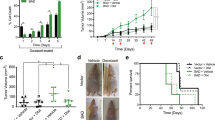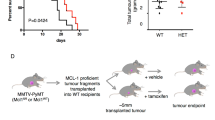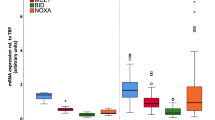Abstract
Antimitotic agents such as taxanes (paclitaxel and docetaxel) have greatly advanced the treatment of breast cancer, although variable patient response and drug toxicity are major limitations. Lack of validated predictive markers for taxane responsiveness precludes a priori identification of patients who are most likely to respond to treatment; thus, a subset of patients endure toxic side effects with marginal benefit. Mechanistic insights into taxane therapeutic activity may lead to rational therapeutic improvements. In this paper we report that the proapoptotic BH3-only protein Bad has a major role in taxane-induced cell death in vitro, and clinically is a prognostic indicator for overall survival of breast cancer patients after adjuvant taxane chemotherapy. Unexpectedly, Bad did not induce the mitochondrial apoptotic machinery in response to taxane treatment. Instead, Bad indirectly facilitated cell death by stimulating cellular proliferation. As dividing cells are the targets of taxane therapy, Bad-stimulated proliferation may be a marker of taxane sensitivity. Our studies indicate that quantification of Bad protein levels may have value as a diagnostic tool. They also suggest that cells expressing Bad are more sensitive to taxanes because of their altered cell cycle dynamics and reveal a clinically relevant proliferative role of Bad in breast cancer.
This is a preview of subscription content, access via your institution
Access options
Subscribe to this journal
Receive 50 print issues and online access
$259.00 per year
only $5.18 per issue
Buy this article
- Purchase on Springer Link
- Instant access to full article PDF
Prices may be subject to local taxes which are calculated during checkout





Similar content being viewed by others
References
Aapro MS . (2001). Adjuvant therapy of primary breast cancer: a review of key findings from the 7th international conference, St Gallen, February 2001. Oncologist 6: 376–385.
Al-Bazz YO, Underwood JC, Brown BL, Dobson PR . (2009). Prognostic significance of Akt, phospho-Akt and BAD expression in primary breast cancer. Eur J Cancer 45: 694–704.
Andreeff M, Jiang S, Zhang X, Konopleva M, Estrov Z, Snell VE et al. (1999). Expression of Bcl-2-related genes in normal and AML progenitors: changes induced by chemotherapy and retinoic acid. Leukemia 13: 1881–1892.
Blagosklonny MV, Fojo T . (1999). Molecular effects of paclitaxel: myths and reality (a critical review). Int J Cancer 83: 151–156.
Bouillet P, Metcalf D, Huang DC, Tarlinton DM, Kay TW, Kontgen F et al. (1999). Proapoptotic Bcl-2 relative Bim required for certain apoptotic responses, leukocyte homeostasis, and to preclude autoimmunity. Science 286: 1735–1738.
Cannings E, Kirkegaard T, Tovey SM, Dunne B, Cooke TG, Bartlett JM . (2007). Bad expression predicts outcome in patients treated with tamoxifen. Breast Cancer Res Treat 102: 173–179.
Chang JC, Makris A, Gutierrez MC, Hilsenbeck SG, Hackett JR, Jeong J et al. (2008). Gene expression patterns in formalin-fixed, paraffin-embedded core biopsies predict docetaxel chemosensitivity in breast cancer patients. Breast Cancer Res Treat 108: 233–240.
Chang JC, Wooten EC, Tsimelzon A, Hilsenbeck SG, Gutierrez MC, Elledge R et al. (2003). Gene expression profiling for the prediction of therapeutic response to docetaxel in patients with breast cancer. Lancet 362: 362–369.
Chattopadhyay A, Chiang CW, Yang E . (2001). BAD/BCL-[X(L)] heterodimerization leads to bypass of G0/G1 arrest. Oncogene 20: 4507–4518.
Chiang CW, Kanies C, Kim KW, Fang WB, Parkhurst C, Xie M et al. (2003). Protein phosphatase 2A dephosphorylation of phosphoserine 112 plays the gatekeeper role for BAD-mediated apoptosis. Mol Cell Biol 23: 6350–6362.
Czernick M, Rieger A, Goping IS . (2009). Bim is reversibly phosphorylated but plays a limited role in paclitaxel cytotoxicity of breast cancer cell lines. Biochem Biophys Res Commun 379: 145–150.
Danial NN . (2008). BAD: undertaker by night, candyman by day. Oncogene 27 (Suppl 1): S53–S70.
Danial NN, Gramm CF, Scorrano L, Zhang CY, Krauss S, Ranger AM et al. (2003). BAD and glucokinase reside in a mitochondrial complex that integrates glycolysis and apoptosis. Nature 424: 952–956.
Danial NN, Walensky LD, Zhang CY, Choi CS, Fisher JK, Molina AJ et al. (2008). Dual role of proapoptotic BAD in insulin secretion and beta cell survival. Nat Med 14: 144–153.
Datta SR, Katsov A, Hu L, Petros A, Fesik SW, Yaffe MB et al. (2000). 14-3-3 proteins and survival kinases cooperate to inactivate BAD by BH3 domain phosphorylation. Mol Cell 6: 41–51.
Datta SR, Ranger AM, Lin MZ, Sturgill JF, Ma YC, Cowan CW et al. (2002). Survival factor-mediated BAD phosphorylation raises the mitochondrial threshold for apoptosis. Dev Cell 3: 631–643.
de Hoon MJ, Imoto S, Nolan J, Miyano S . (2004). Open source clustering software. Bioinformatics 20: 1453–1454.
Derry WB, Wilson L, Jordan MA . (1998). Low potency of taxol at microtubule minus ends: implications for its antimitotic and therapeutic mechanism. Cancer Res 58: 1177–1184.
Eisen MB, Spellman PT, Brown PO, Botstein D . (1998). Cluster analysis and display of genome-wide expression patterns. Proc Natl Acad Sci USA 95: 14863–14868.
Fernando R, Foster JS, Bible A, Strom A, Pestell RG, Rao M et al. (2007). Breast cancer cell proliferation is inhibited by BAD: regulation of cyclin D1. J Biol Chem 282: 28864–28873.
Fernando RI, Wimalasena J . (2004). Estradiol abrogates apoptosis in breast cancer cells through inactivation of BAD: Ras-dependent nongenomic pathways requiring signaling through ERK and Akt. Mol Biol Cell 15: 3266–3284.
Gascoigne KE, Taylor SS . (2008). Cancer cells display profound intra- and interline variation following prolonged exposure to antimitotic drugs. Cancer Cell 14: 111–122.
Gascoigne KE, Taylor SS . (2009). How do anti-mitotic drugs kill cancer cells? J Cell Sci 122: 2579–2585.
Gilmore AP, Valentijn AJ, Wang P, Ranger AM, Bundred N, O'Hare MJ et al. (2002). Activation of BAD by therapeutic inhibition of epidermal growth factor receptor and transactivation by insulin-like growth factor receptor. J Biol Chem 277: 27643–27650.
Goping IS, Gross A, Lavoie JN, Nguyen M, Jemmerson R, Roth K et al. (1998). Regulated targeting of BAX to mitochondria. J Cell Biol 143: 207–215.
Graham KA, Trent JM, Osborne CK, McGrath CM, Minden MD, Buick RN . (1986). The use of restriction fragment polymorphisms to identify the cell line MCF-7. Breast Cancer Res Treat 8: 29–34.
Janicke RU, Sprengart ML, Wati MR, Porter AG . (1998). Caspase-3 is required for DNA fragmentation and morphological changes associated with apoptosis. J Biol Chem 273: 9357–9360.
Janumyan Y, Cui Q, Yan L, Sansam CG, Valentin M, Yang E . (2008). G0 function of BCL2 and BCL-xL requires BAX, BAK, and p27 phosphorylation by Mirk, revealing a novel role of BAX and BAK in quiescence regulation. J Biol Chem 283: 34108–34120.
Janumyan YM, Sansam CG, Chattopadhyay A, Cheng N, Soucie EL, Penn LZ et al. (2003). Bcl-xL/Bcl-2 coordinately regulates apoptosis, cell cycle arrest and cell cycle entry. EMBO J 22: 5459–5470.
Jordan MA, Toso RJ, Thrower D, Wilson L . (1993). Mechanism of mitotic block and inhibition of cell proliferation by taxol at low concentrations. Proc Natl Acad Sci USA 90: 9552–9556.
Jordan MA, Wendell K, Gardiner S, Derry WB, Copp H, Wilson L . (1996). Mitotic block induced in HeLa cells by low concentrations of paclitaxel (Taxol) results in abnormal mitotic exit and apoptotic cell death. Cancer Res 56: 816–825.
Kelekar A, Chang BS, Harlan JE, Fesik SW, Thompson CB . (1997). Bad is a BH3 domain-containing protein that forms an inactivating dimer with Bcl-XL. Mol Cell Biol 17: 7040–7046.
Kitada S, Krajewska M, Zhang X, Scudiero D, Zapata JM, Wang HG et al. (1998). Expression and location of pro-apoptotic Bcl-2 family protein BAD in normal human tissues and tumor cell lines. Am J Pathol 152: 51–61.
Klumpp S, Selke D, Krieglstein J . (2003). Protein phosphatase type 2C dephosphorylates BAD. Neurochem Int 42: 555–560.
Letai AG . (2008). Diagnosing and exploiting cancer's addiction to blocks in apoptosis. Nat Rev Cancer 8: 121–132.
Li R, Moudgil T, Ross HJ, Hu HM . (2005). Apoptosis of non-small-cell lung cancer cell lines after paclitaxel treatment involves the BH3-only proapoptotic protein Bim. Cell Death Differ 12: 292–303.
Liu QY, Stein CA . (1997). Taxol and estramustine-induced modulation of human prostate cancer cell apoptosis via alteration in bcl-xL and bak expression. Clin Cancer Res 3: 2039–2046.
Lizcano JM, Morrice N, Cohen P . (2000). Regulation of BAD by cAMP-dependent protein kinase is mediated via phosphorylation of a novel site, Ser155. Biochem J 349: 547–557.
Matschinsky FM, Ellerman JE . (1968). Metabolism of glucose in the islets of Langerhans. J Biol Chem 243: 2730–2736.
McGrogan BT, Gilmartin B, Carney DN, McCann A . (2008). Taxanes, microtubules and chemoresistant breast cancer. Biochim Biophys Acta 1785: 96–132.
Metcalfe AD, Gilmore A, Klinowska T, Oliver J, Valentijn AJ, Brown R et al. (1999). Developmental regulation of Bcl-2 family protein expression in the involuting mammary gland. J Cell Sci 112 (Part 11): 1771–1783.
Noguchi S . (2006). Predictive factors for response to docetaxel in human breast cancers. Cancer Sci 97: 813–820.
Osborne CK, Hobbs K, Trent JM . (1987). Biological differences among MCF-7 human breast cancer cell lines from different laboratories. Breast Cancer Res Treat 9: 111–121.
Pellegrini F, Budman DR . (2005). Review: tubulin function, action of antitubulin drugs, and new drug development. Cancer Invest 23: 264–273.
Perez EA . (1999). Current management of metastatic breast cancer. Semin Oncol 26: 1–10.
Peruzzi F, Prisco M, Dews M, Salomoni P, Grassilli E, Romano G et al. (1999). Multiple signaling pathways of the insulin-like growth factor 1 receptor in protection from apoptosis. Mol Cell Biol 19: 7203–7215.
Ranger AM, Zha J, Harada H, Datta SR, Danial NN, Gilmore AP et al. (2003). Bad-deficient mice develop diffuse large B cell lymphoma. Proc Natl Acad Sci USA 100: 9324–9329.
Roy SS, Madesh M, Davies E, Antonsson B, Danial N, Hajnoczky G . (2009). Bad targets the permeability transition pore independent of Bax or Bak to switch between Ca(2+)-dependent cell survival and death. Mol Cell 33: 377–388.
Saldanha AJ . (2004). Java Treeview—extensible visualization of microarray data. Bioinformatics 20: 3246–3248.
Schorr K, Li M, Krajewski S, Reed JC, Furth PA . (1999). Bcl-2 gene family and related proteins in mammary gland involution and breast cancer. J Mammary Gland Biol Neoplasia 4: 153–164.
Shimamura A, Ballif BA, Richards SA, Blenis J . (2000). Rsk1 mediates a MEK-MAP kinase cell survival signal. Curr Biol 10: 127–135.
Smith AJ, Karpova Y, D'Agostino Jr R, Willingham M, Kulik G . (2009). Expression of the Bcl-2 protein BAD promotes prostate cancer growth. PLoS One 4: e6224.
Sunters A, Fernandez de Mattos S, Stahl M, Brosens JJ, Zoumpoulidou G, Saunders CA et al. (2003). FoxO3a transcriptional regulation of Bim controls apoptosis in paclitaxel-treated breast cancer cell lines. J Biol Chem 278: 49795–49805.
Swanton C, Marani M, Pardo O, Warne PH, Kelly G, Sahai E et al. (2007). Regulators of mitotic arrest and ceramide metabolism are determinants of sensitivity to paclitaxel and other chemotherapeutic drugs. Cancer Cell 11: 498–512.
Tan TT, Degenhardt K, Nelson DA, Beaudoin B, Nieves-Neira W, Bouillet P et al. (2005). Key roles of BIM-driven apoptosis in epithelial tumors and rational chemotherapy. Cancer Cell 7: 227–238.
Tan Y, Demeter MR, Ruan H, Comb MJ . (2000). BAD Ser-155 phosphorylation regulates BAD/Bcl-XL interaction and cell survival. J Biol Chem 275: 25865–25869.
Upreti M, Galitovskaya EN, Chu R, Tackett AJ, Terrano DT, Granell S et al. (2008). Identification of the major phosphorylation site in Bcl-xL induced by microtubule inhibitors and analysis of its functional significance. J Biol Chem 283: 35517–35525.
Virdee K, Parone PA, Tolkovsky AM . (2000). Phosphorylation of the pro-apoptotic protein BAD on serine 155, a novel site, contributes to cell survival. Curr Biol 10: 1151–1154.
Weaver BA, Cleveland DW . (2005). Decoding the links between mitosis, cancer, and chemotherapy: the mitotic checkpoint, adaptation, and cell death. Cancer Cell 8: 7–12.
Yang E, Zha J, Jockel J, Boise LH, Thompson CB, Korsmeyer SJ . (1995). Bad, a heterodimeric partner for Bcl-XL and Bcl-2, displaces Bax and promotes cell death. Cell 80: 285–291.
Youle RJ, Strasser A . (2008). The BCL-2 protein family: opposing activities that mediate cell death. Nat Rev Mol Cell Biol 9: 47–59.
Yvon AM, Wadsworth P, Jordan MA . (1999). Taxol suppresses dynamics of individual microtubules in living human tumor cells. Mol Biol Cell 10: 947–959.
Zha J, Harada H, Osipov K, Jockel J, Waksman G, Korsmeyer SJ . (1997). BH3 domain of BAD is required for heterodimerization with BCL-XL and pro-apoptotic activity. J Biol Chem 272: 24101–24104.
Zha J, Harada H, Yang E, Jockel J, Korsmeyer SJ . (1996). Serine phosphorylation of death agonist BAD in response to survival factor results in binding to 14-3-3 not BCL-X(L). Cell 87: 619–628.
Zhou XM, Liu Y, Payne G, Lutz RJ, Chittenden T . (2000). Growth factors inactivate the cell death promoter BAD by phosphorylation of its BH3 domain on Ser155. J Biol Chem 275: 25046–25051.
Zinkel S, Gross A, Yang E . (2006). BCL2 family in DNA damage and cell cycle control. Cell Death Differ 13: 1351–1359.
Acknowledgements
We thank Drs Thomas Simmen, Roseline Godbout and Simonetta Sipione for helpful discussions, Ms Yisu Li for assistance with gene expression microarray analysis and Ms Cheryl Santos for excellent technical input. We also thank the anonymous reviewers for insightful suggestions that improved this study. ACC is a recipient of a QEII Graduate Scholarship. DAU is supported by the Mary Johnston Melanoma Research Chair. ISG is a recipient of a Recruitment Award from the Alberta Cancer Research Institute. This work was supported by operating grants from the Alberta Cancer Research Institute and the Canadian Breast Cancer Foundation awarded to ISG.
Author information
Authors and Affiliations
Corresponding author
Ethics declarations
Competing interests
The authors declare no conflict of interest.
Additional information
Supplementary Information accompanies the paper on the Oncogene website
Rights and permissions
About this article
Cite this article
Craik, A., Veldhoen, R., Czernick, M. et al. The BH3-only protein Bad confers breast cancer taxane sensitivity through a nonapoptotic mechanism. Oncogene 29, 5381–5391 (2010). https://doi.org/10.1038/onc.2010.272
Received:
Revised:
Accepted:
Published:
Issue Date:
DOI: https://doi.org/10.1038/onc.2010.272
Keywords
This article is cited by
-
Emerging biomarkers and potential therapeutics of the BCL-2 protein family: the apoptotic and anti-apoptotic context
Egyptian Journal of Medical Human Genetics (2024)
-
BAD regulates mammary gland morphogenesis by 4E-BP1-mediated control of localized translation in mouse and human models
Nature Communications (2021)
-
BAD sensitizes breast cancer cells to docetaxel with increased mitotic arrest and necroptosis
Scientific Reports (2020)
-
Non-canonical BAD activity regulates breast cancer cell and tumor growth via 14-3-3 binding and mitochondrial metabolism
Oncogene (2019)
-
Targeting proapoptotic protein BAD inhibits survival and self-renewal of cancer stem cells
Cell Death & Differentiation (2014)



